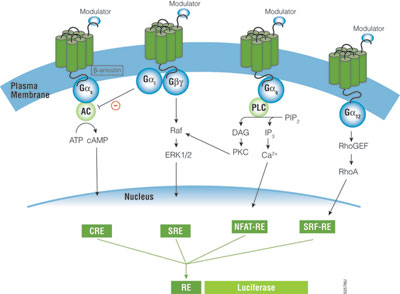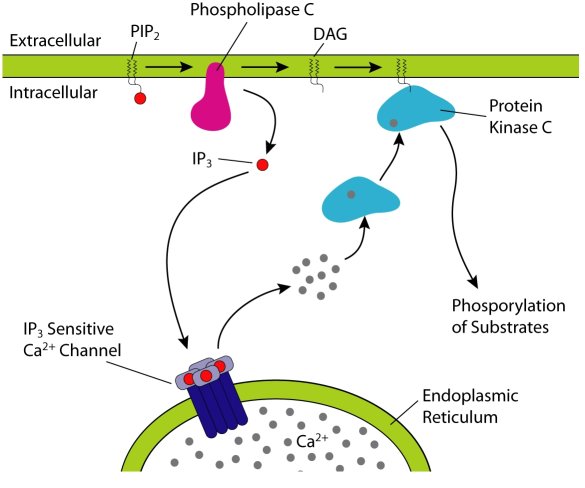Cascades: Difference between revisions
| Line 80: | Line 80: | ||
activation of phospholipase C activity by tachykinin receptor signaling pathway ; GO:0007209 | activation of phospholipase C activity by tachykinin receptor signaling pathway ; GO:0007209 | ||
inhibition of phospholipase C activity involved in G-protein coupled receptor signaling ; GO:0030845 | inhibition of phospholipase C activity involved in G-protein coupled receptor signaling ; GO:0030845 | ||
| Line 89: | Line 86: | ||
second-messenger-mediated signaling ; GO:0019932 | second-messenger-mediated signaling ; GO:0019932 | ||
A series of molecular signals in which an ion or small molecule is formed or released into the cytosol, thereby helping relay the signal within the cell. | A series of molecular signals in which an ion or small molecule is formed or released into the cytosol, thereby helping relay the signal within the cell. | ||
G-protein signaling, coupled to cyclic nucleotide second messenger ; GO:0007187 | G-protein signaling, coupled to cyclic nucleotide second messenger ; GO:0007187 | ||
| Line 99: | Line 94: | ||
For an overview of second-messenger signaling, see [http://en.wikipedia.org/wiki/Second_messenger_system Wikipedia] | For an overview of second-messenger signaling, see [http://en.wikipedia.org/wiki/Second_messenger_system Wikipedia] and the diagram below. | ||
[[File:GPCR_overview.jpg]] | |||
The route of the signal depends on the type of G protein. The main routes are: | |||
*1. cAMP system | |||
** 1a. Gs protein activates adenylate cyclase to promote formation of cAMP | |||
** 1b. Gi protein inhibits adenylate cyclase to inhibit formation of cAMP | |||
[[File:GPCR_AC1.jpg]] | |||
[[File:GPCR_GiAC.jpg]] | |||
*2. IP3 system: Gq protein activates PLC, to promote formation of IP3 and DAG. IP3 binds to receptors on the ER, which causes release of Ca++ into the cytosol. DAG reimains tethered to the plasma membrane where it recruits PKC. PKC goes on to phosphorylate a range of molecules. | |||
[[File:Pip2_cleavage_to_IP3_and_DAG.jpg]] | |||
==Naming The Cascades== | ==Naming The Cascades== | ||
Revision as of 09:02, 14 September 2011
Return to GOC Main Page
Return to Signaling Main Page [[1]]
Connecting Intracellular Cascades To Cell Surface Receptors
- For the problems of connecting the intracellular signaling cascades with the cell surface receptors above them, see slides 26-32 of the overview from the LA GOC meeting, May 2011.
- From the GO signaling workshop and the LA 2011 GO meeting, it was agreed that 'VIA' (and HAS_PART relationships) was the most appropriate syntax for these terms.
EDITS: SEPTEMBER 8th 2011
OBSOLETED: intracellular signal transduction involved in cell surface receptor linked signaling ; GO:0035557 phosphatidylinositol 3-kinase cascade involved in insulin receptor signaling ; GO:0035558 MAPKKK cascade involved in epidermal growth factor receptor signaling ; GO:0035559
Created new Replacement Terms:
id: GO:0038028 name: insulin receptor signaling pathway via phosphatidylinositol 3-kinase cascade namespace: biological_process def: "The series of molecular signals generated as a consequence of the insulin receptor binding to its physiological ligand, where the signal is passed on via the phosphatidylinositol 3-kinase cascade." [GOC:bf, GOC:signaling, PMID:19322168, PMID:20696212] synonym: "insulin receptor signaling pathway via PI3K cascade" EXACT [GOC:bf] synonym: "insulin receptor signaling via PI3K" EXACT [GOC:bf] is_a: GO:0008286 ! insulin receptor signaling pathway relationship: has_part GO:0014065 ! phosphatidylinositol 3-kinase cascade
id: GO:0038029 name: epidermal growth factor receptor signaling pathway via MAPKKK cascade namespace: biological_process def: "The series of molecular signals generated as a consequence of an epidermal growth factor receptor binding to one of its physiological ligands, where the signal is passed on via the MAPKKK cascade." [GOC:bf, GOC:signaling, PMID:21167805] synonym: "EGFR signaling pathway via MAPKKK cascade" EXACT [GOC:bf] synonym: "EGFR signaling via MAPKKK cascade" EXACT [GOC:bf] synonym: "EGFR/MAPK signaling" EXACT [GOC:bf] synonym: "epidermal growth factor receptor signalling pathway via MAPKKK cascade" EXACT [GOC:bf] is_a: GO:0007173 ! epidermal growth factor receptor signaling pathway relationship: has_part GO:0000165 ! MAPKKK cascade
For SF:3023417, created: non-canonical Wnt receptor signaling pathway via MAPKKK cascade ; GO:0038030 non-canonical Wnt receptor signaling pathway via JNK cascade ; GO:0038031
Related SourceForge Items
- PI3K/AKT signaling: https://sourceforge.net/tracker/?func=detail&aid=3008502&group_id=36855&atid=440764
- Wnt signaling via JNK: https://sourceforge.net/tracker/?func=detail&aid=3023417&group_id=36855&atid=440764 DONE
- Regulation of Wnt signaling by Hippo signaling: https://sourceforge.net/tracker/?func=detail&aid=3032564&group_id=36855&atid=440764
- Opoid receptor signaling: https://sourceforge.net/tracker/?func=detail&aid=3196318&group_id=36855&atid=440764
- Activation of phospholipase C by GPCR signaling: https://sourceforge.net/tracker/?func=detail&aid=3117691&group_id=36855&atid=440764
GPCR signaling
Currently (Sept 11), the GPCR terms use 'by' in their name. This doesn't seem correct as it implies that activation of AC activity is downstream of the pathway. In GO, the pathway begins with receptor-ligand binding and ends with regulation of a downstream cellular effect (normally transcription), so I think AC, PLC etc are all part of the GPCR signaling pathway.
positive regulation of adenylate cyclase activity by G-protein signaling pathway ; GO:0010579 activation of adenylate cyclase activity by G-protein signaling pathway ; GO:0007189 activation of adenylate cyclase activity by adrenergic receptor signaling pathway ; GO:0071880 activation of adenylate cyclase activity by dopamine receptor signaling pathway ; GO:0007191 activation of adenylate cyclase activity by glucose-triggered G-protein signaling pathway ; GO:0010619 activation of adenylate cyclase activity by serotonin receptor signaling pathway
activation of protein kinase C activity by G-protein coupled receptor protein signaling pathway ; GO:0007205
activation of phospholipase D activity by G-protein coupled receptor protein signaling pathway ; GO:0031583
activation of phospholipase C activity by G-protein coupled receptor protein signaling pathway coupled to IP3 second messenger ; GO:0007200 activation of phospholipase C activity by adrenergic receptor signaling pathway ; GO:0071882 activation of phospholipase C activity by dopamine receptor signaling pathway ; GO:0060158 negative regulation of phospholipase C-activating dopamine receptor signaling pathway ; GO:0060162 activation of phospholipase C activity by metabotropic glutamate receptor signaling pathway ; GO:0007206 activation of phospholipase C activity by muscarinic acetylcholine receptor signaling pathway ; GO:0007207 activation of phospholipase C activity by serotonin receptor signaling pathway ; GO:0007208 activation of phospholipase C activity by tachykinin receptor signaling pathway ; GO:0007209 inhibition of phospholipase C activity involved in G-protein coupled receptor signaling ; GO:0030845
Therefore, these GPCR signaling pathway terms need to be changed to 'VIA' syntax with HAS_PART relationships, similar to other pathways. One issue, is that they need to tie in with the second-messenger-mediated signaling terms:
second-messenger-mediated signaling ; GO:0019932 A series of molecular signals in which an ion or small molecule is formed or released into the cytosol, thereby helping relay the signal within the cell.
G-protein signaling, coupled to cyclic nucleotide second messenger ; GO:0007187 G-protein signaling, coupled to cAMP nucleotide second messenger ; GO:0007188 G-protein signaling, coupled to cGMP nucleotide second messenger ; GO:0007199 G-protein signaling, coupled to S1P second messenger (sphingosine kinase activating) ; GO:0001789 rhodopsin mediated G-protein signaling, coupled to IP3 second messenger ; GO:0030265
For an overview of second-messenger signaling, see Wikipedia and the diagram below.
The route of the signal depends on the type of G protein. The main routes are:
- 1. cAMP system
- 1a. Gs protein activates adenylate cyclase to promote formation of cAMP
- 1b. Gi protein inhibits adenylate cyclase to inhibit formation of cAMP
- 2. IP3 system: Gq protein activates PLC, to promote formation of IP3 and DAG. IP3 binds to receptors on the ER, which causes release of Ca++ into the cytosol. DAG reimains tethered to the plasma membrane where it recruits PKC. PKC goes on to phosphorylate a range of molecules.
Naming The Cascades
For the problems of connecting the intracellular signaling cascades with the cell surface receptors above them, see slide 32 of the overview from the LA GOC meeting, May 2011.
IN SUMMARY:
- There was a concern that ‘cascade’ implied amplification of a signal.
- The SWG and experts discussed various options including 'cascade, cassette, module'.
- It was decided to stick with 'cascade' in GO, and making it clear in the definitions that amplification of a signal was not required.
Cascade Problems Still To Address
Q: Where does a cascade start and stop?
Intracellular signaling units can be split into those that are a group of proteins:
- MAPKKK cascade
- JNK cascade
- Hippo cascade
and those that are really just one mediator/protein:
- PI3K
- PKB (aka AKT) (NB: PI3K and AKT NORMALLY (but not always) signal together so we need to look at how we can connect them.
- TOR
- Ca++ signaling
- Activation/inhibition of adenylate cyclase in GPCR signaling
For those that are just one mediator, it's harder to define a start and stop point. Where, for example, does the PI3K cascade begin and end? For these, it may be easier to rename them to 'PI3K signaling'. If we keep it as an instance of intracellular signal transduction, it can be defined as any signaling event within the cell where PI3K passes the signal on.



